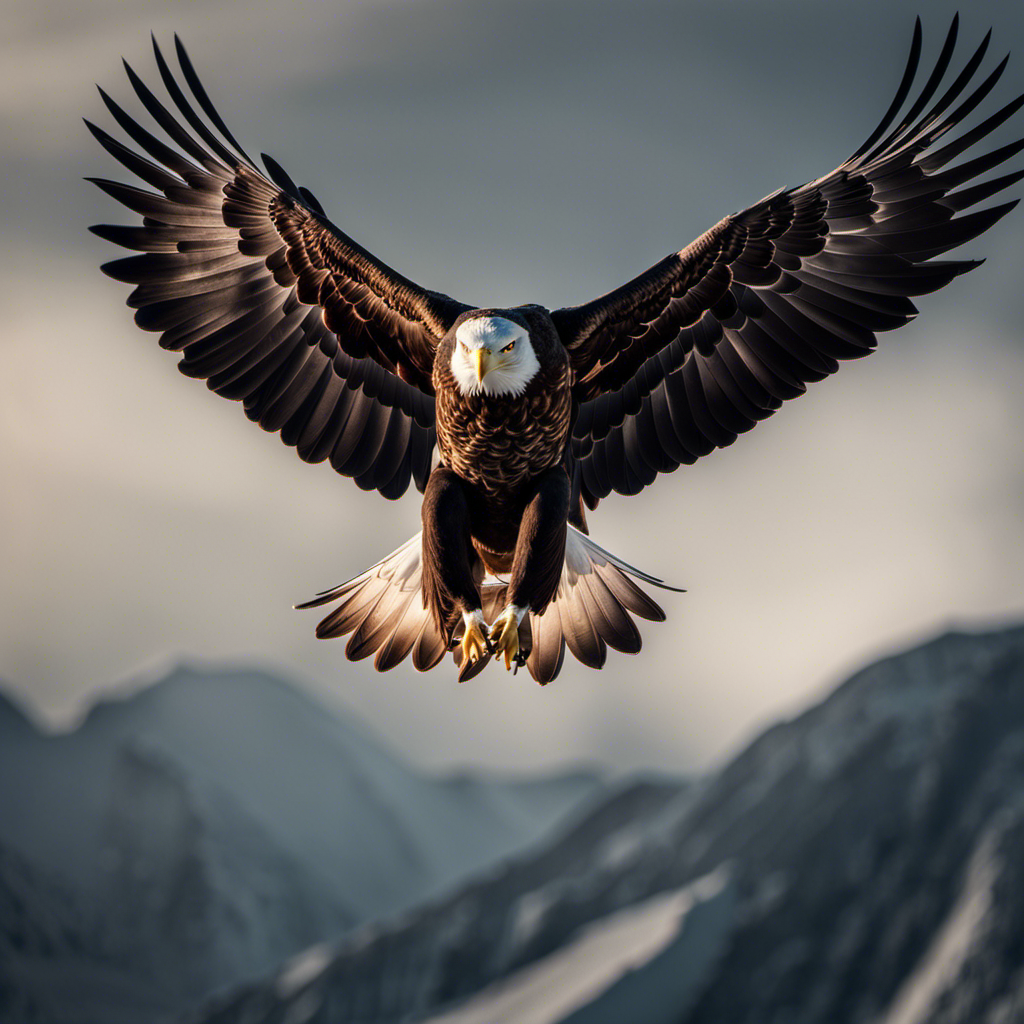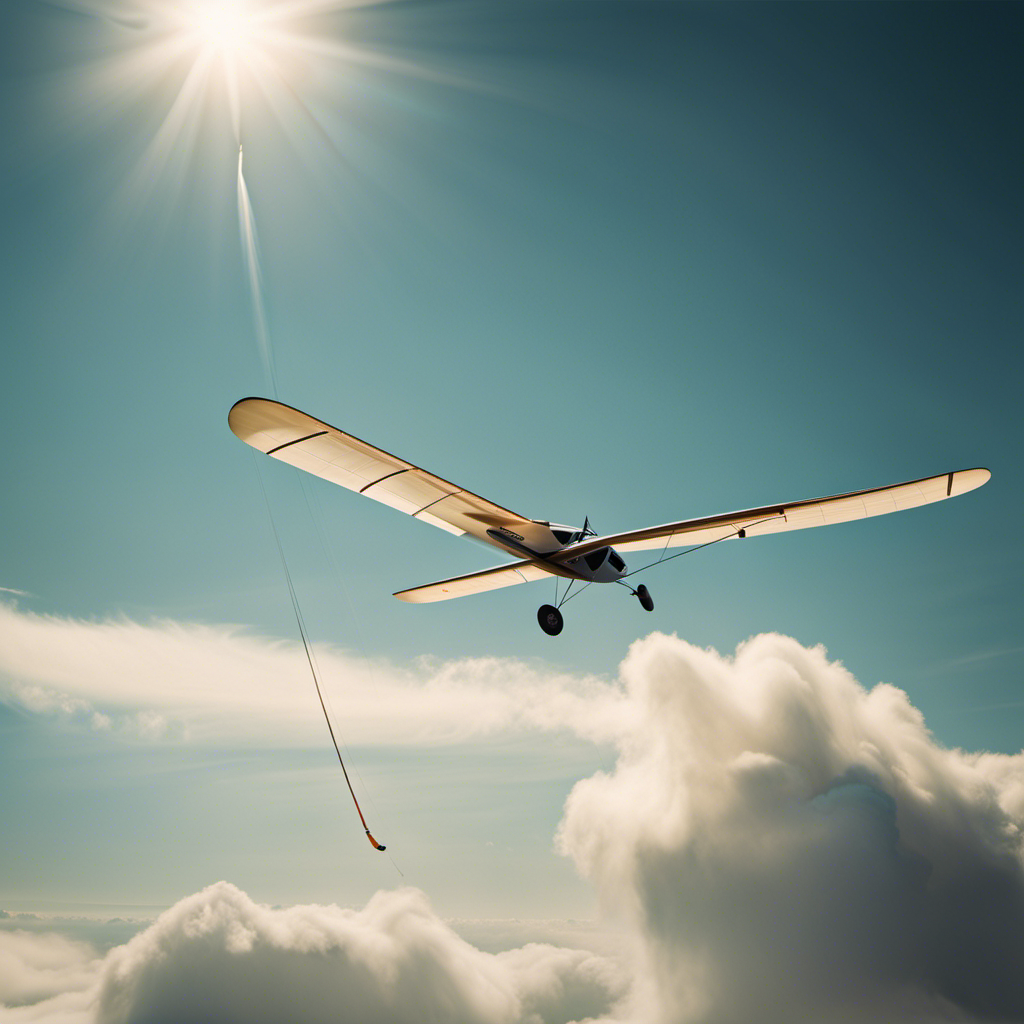As a glider pilot, I have learned that “calm skies lead to lofty flights.” Weather is a crucial factor in determining whether the gliding experience will be thrilling or disappointing.
In this article, we’ll explore the key factors that determine the best weather for gliding. From wind speed and atmospheric stability to cloud cover and air density, understanding these elements is crucial for a successful and enjoyable gliding experience.
So, let’s dive into the technicalities and discover the perfect weather for taking to the skies!
Key Takeaways
- Thermals generated by rapid temperature increase provide high availability and excellent quality for gliders.
- High barometric pressure indicates stable weather conditions, ideal for gliding.
- Precipitation, especially heavy rain and snow, can reduce visibility and increase the risk of aircraft icing.
- Air density, influenced by air pressure and altitude, affects glide performance.
Wind Speed and Direction
The wind’s speed and direction significantly impact the glide performance. As a glider pilot, understanding and adapting to the conditions created by the wind is crucial for a successful flight. One important factor to consider is wind shear, which refers to the change in wind speed or direction with altitude. Wind shear can affect the glider’s ability to maintain a steady glide path, making it necessary to constantly adjust the controls to compensate for the changing conditions.
Another factor influenced by wind is ridge lift. When the wind encounters an obstruction, such as a hill or mountain, it is forced to rise. This upward movement creates an area of rising air known as ridge lift. Glider pilots can take advantage of this lift by flying close to the ridge, allowing the wind to carry them upward and extend their flight time.
Understanding the wind’s speed and direction, as well as its interaction with the terrain, is essential for glider pilots to maximize their performance. However, wind is just one component of the overall weather conditions that affect gliding. Atmospheric stability, which will be discussed in the next section, is another crucial factor that must be considered for a safe and efficient flight.
Atmospheric Stability
Although it’s important to have other factors in place, the ideal weather for gliding is when the atmosphere is stable. Atmospheric stability refers to the condition where the air is not prone to vertical movement. This is crucial for gliding as it allows the glider to maintain a steady altitude and glide smoothly through the air.
One key factor that affects atmospheric stability is the presence of inversion layers. Inversion layers occur when the temperature increases with height, instead of the usual decrease. This creates a barrier that prevents warm air from rising and mixing with the cooler air above. As a result, the atmosphere becomes more stable, providing favorable conditions for gliding.
Another important aspect to consider is the lapse rate, which is the rate at which the temperature decreases with altitude. A steep lapse rate indicates unstable conditions, as the air is more likely to rise and form convective currents. On the other hand, a shallow lapse rate indicates a stable atmosphere, making it ideal for gliding.
In conclusion, gliding enthusiasts look for stable atmospheric conditions with the presence of inversion layers and a shallow lapse rate. These factors ensure a smooth and controlled gliding experience.
Now, let’s explore another crucial aspect of gliding weather: visibility.
Visibility
Visibility plays a crucial role in ensuring safe and successful gliding experiences. As a glider pilot, I understand the importance of clear visibility for maintaining situational awareness and avoiding potential hazards.
Here are four factors that evoke an emotional response when it comes to visibility in gliding:
-
Foggy conditions: Imagine being surrounded by thick fog, unable to see beyond a few feet. The sense of disorientation and vulnerability can be overwhelming, making it nearly impossible to navigate and land safely.
-
Haze: The presence of haze in the air can significantly reduce visibility, creating a hazy and blurred environment. It feels like flying through a murky atmosphere, where distinguishing landscape features becomes challenging, increasing the risk of collision.
-
Smog: Pollution and smog can severely impact visibility, transforming clear skies into a hazy, smoky mess. The feeling of being enveloped in a toxic cloud is unsettling, affecting not only visibility but also the overall flying experience.
-
Limited field of view: When visibility is compromised, the ability to scan the surroundings and anticipate potential obstacles diminishes. This restriction in the field of view can induce feelings of anxiety and unease, affecting the pilot’s confidence and decision-making abilities.
Now, let’s explore how cloud cover further influences gliding conditions.
Cloud Cover
Cloud cover can greatly impact a glider pilot’s ability to navigate and make informed decisions while flying. When gliding in clear skies, the pilot has a clear view of the landscape below, making it easier to identify landmarks and plan their route accordingly. However, when the sky is overcast, visibility is reduced, making it more challenging to navigate and maintain situational awareness.
Overcast conditions also have a significant impact on gliding performance. The absence of direct sunlight can limit the availability of thermals, which are essential for maintaining altitude and prolonging flight time. Thermals are pockets of rising warm air that glider pilots rely on to gain height. When the sky is covered with clouds, the sun’s rays cannot penetrate through, resulting in fewer thermals and less lift for gliders.
Additionally, overcast conditions can create a more stable atmosphere, reducing the likelihood of strong and consistent updrafts. This stability can make it difficult for glider pilots to maintain altitude and achieve the desired flight path.
Transitioning into the subsequent section about temperature, it is important to note that cloud cover can also influence the atmospheric temperature.
Temperature
The temperature can have a significant impact on glider performance and flight conditions. Temperature variations play a crucial role in determining the quality of the soaring experience.
Gliders are highly sensitive to changes in temperature, as it affects the density of the air and influences the lift available for sustained flight. As temperatures rise, the air becomes less dense, reducing the glider’s ability to generate lift. Conversely, colder temperatures increase air density, resulting in better lift conditions for gliders.
Weather patterns heavily influence temperature fluctuations, and understanding these patterns is essential for glider pilots. For example, during a cold front, cooler temperatures can create stable air masses that limit the potential for thermals and soaring. On the other hand, warm fronts can bring in higher temperatures and unstable conditions, creating favorable thermal activity for gliders.
By monitoring temperature variations and analyzing weather patterns, glider pilots can optimize their flight plans and take advantage of the best conditions for soaring.
Transitioning into the subsequent section about thermal activity, these temperature changes are closely linked to the formation of thermals and their availability for gliding.
Thermal Activity
To maximize your flying experience, monitor temperature changes closely as they directly impact the availability and quality of thermals for gliding. Soaring techniques rely heavily on thermals, which are columns of warm air that rise from the surface. As the sun heats the Earth’s surface, it creates temperature variations that generate thermals. These thermals are essential for gliders to gain altitude and stay aloft for extended periods.
To understand the relationship between thermals and temperature, let’s take a look at the following table:
| Temperature Change | Thermal Availability | Thermal Quality |
|---|---|---|
| Rapid Increase | High | Excellent |
| Slow Increase | Moderate | Good |
| Stable | Low | Poor |
As the temperature rapidly increases, the availability and quality of thermals are high, providing excellent soaring conditions. Conversely, a stable temperature with little change results in low thermal availability and poor thermal quality, making it challenging to sustain flight.
It’s interesting to note that birds also rely on thermals for efficient migration. By utilizing thermals, birds can conserve energy and cover long distances. Understanding the relationship between temperature and thermals not only enhances your gliding experience but also provides insights into the natural world around us.
With a solid understanding of temperature and its impact on thermals, let’s transition into the next section about barometric pressure and its role in gliding conditions.
Barometric Pressure
Keep an eye on barometric pressure because it directly affects the performance of your glider. Barometric pressure is the measure of atmospheric pressure at a given location. It plays a crucial role in determining the conditions for gliding.
High barometric pressure typically indicates stable weather conditions with clear skies and calm winds. This is ideal for gliding as it allows for smooth and predictable air currents, making it easier to maintain altitude and navigate.
On the other hand, low barometric pressure indicates unstable weather conditions with the potential for turbulence and storms. In such conditions, gliders may experience more challenging flying conditions, requiring the pilot to be more vigilant and adapt their techniques accordingly. For instance, they may need to anticipate stronger updrafts and downdrafts and adjust their speed and altitude accordingly.
Additionally, understanding the effects of barometric pressure on aircraft performance is essential for making informed decisions during flight planning and adjusting gliding techniques in different barometric conditions. This knowledge enables pilots to optimize their gliding experience and ensure a safe and enjoyable flight.
Understanding the impact of barometric pressure is crucial, especially when transitioning into the subsequent section about precipitation, as it helps us anticipate the weather conditions that may affect our gliding experience.
Precipitation
Make sure you check the radar for any signs of rain or snow before taking off. Rainy conditions can significantly impact gliding operations, reducing visibility and increasing the risk of aircraft icing. Similarly, snowfall intensity can create hazardous conditions on the ground and in the air. It is essential to assess the weather conditions to ensure a safe and successful flight.
To better understand the impact of precipitation on gliding, let’s take a look at the following table:
| Weather Condition | Impact on Gliding |
|---|---|
| Light Rain | Reduced visibility, potential for aircraft icing |
| Heavy Rain | Poor visibility, increased risk of aircraft icing |
| Light Snow | Reduced visibility, potential for aircraft icing |
| Heavy Snow | Extremely poor visibility, increased risk of aircraft icing |
| Freezing Rain | Dangerous condition due to potential ice accumulation |
As you can see, both rain and snow can have adverse effects on gliding operations. The intensity of the precipitation directly affects visibility and the likelihood of aircraft icing. Therefore, it is crucial to carefully evaluate the weather conditions before embarking on a gliding adventure.
Understanding the impact of precipitation on gliding is just one aspect of ensuring a safe flight. Another crucial factor to consider is air density.
Air Density
Assessing the air density is essential for determining the optimal glide performance. It is crucial for any glider pilot to have a good understanding of the air pressure and altitude in order to make informed decisions during a flight. Here are two key points to consider:
-
Air pressure: The density of the air is directly influenced by the air pressure. Higher air pressure indicates denser air, which provides better lift for gliders. Lower air pressure, on the other hand, means thinner air and less lift. Therefore, knowing the current air pressure is vital for predicting the glider’s performance.
-
Altitude: As we ascend in altitude, the air pressure decreases, resulting in thinner air. This decrease in air density affects the glider’s ability to maintain lift. Pilots must take into account the altitude at which they are flying to adjust their glide performance accordingly.
Understanding the relationship between air pressure and altitude allows glider pilots to optimize their glide performance. By constantly monitoring these factors, pilots can make precise adjustments to their flight plan, maximizing their chances of staying aloft.
Now, let’s delve into another critical factor that affects gliding: local topography.
Local Topography
Take a moment to consider the impact of local topography on your gliding experience. The local climate and geographical features play a crucial role in determining the suitability of an area for gliding. Let’s explore how these factors can affect your gliding adventure.
One of the key aspects to consider is the presence of mountains or hills in the area. These natural barriers can create unique wind patterns, known as lee waves, which can be utilized by gliders to gain altitude and extend their flight time. The table below provides an overview of different types of local topography and their impact on gliding:
| Topography | Impact on Gliding |
|---|---|
| Mountains | Lee waves |
| Hills | Ridge lift |
| Valleys | Valley winds |
| Coastal areas | Sea breezes |
In addition to topography, the local climate also plays a significant role in gliding. Areas with consistent thermal activity, such as regions with warm air rising from the ground, are ideal for gliders as they provide opportunities for sustained soaring. On the other hand, areas with unstable weather conditions, such as frequent thunderstorms or strong gusty winds, may pose challenges and require careful planning.
Understanding the local climate and geographical features is essential for gliders to choose the best locations for their flights. By taking advantage of the unique wind patterns and thermal activities that local topography and climate offer, gliders can enhance their experience and make the most of their time in the air.
Frequently Asked Questions
Are there any specific weather conditions that make gliding more challenging or dangerous?
Gliding can be more challenging and dangerous in adverse weather conditions such as strong winds, turbulence, thunderstorms, or low visibility. These conditions can affect the glider’s stability, control, and overall safety.
How does the altitude affect gliding conditions?
Altitude greatly affects gliding conditions. As altitude increases, air density decreases, resulting in decreased lift and gliding performance. Higher altitudes require more skill and precision to maintain glider control and maximize efficiency.
Is there a particular time of day that is better for gliding?
The best time for gliding is typically during the late morning or early afternoon when thermals are stronger and more abundant. Ideal weather conditions include clear skies, light winds, and stable atmospheric conditions.
Can gliding be done in urban areas or is it better to find more open spaces?
Gliding is better suited to open spaces rather than urban areas due to the limited airspace and potential hazards. Urban gliding can be risky, while open space gliding provides more room for maneuvering and safety.
Are there any specific weather patterns or phenomena that can enhance gliding conditions?
Thermal dynamics and wind patterns greatly influence gliding conditions. Understanding these phenomena is crucial for maximizing gliding performance. By studying weather patterns and their effects on air currents, gliders can identify favorable conditions for safe and efficient flights.
Conclusion
In conclusion, achieving the perfect weather conditions for gliding entails a delicate balance of various factors. The wind speed and direction must be favorable, ensuring smooth air currents that facilitate maneuverability.
Atmospheric stability guarantees a safe and predictable flight experience. Optimal visibility and cloud cover enable pilots to navigate with ease and confidence.
Temperature, barometric pressure, precipitation, and air density all play crucial roles in determining the overall glide experience. Lastly, the local topography can provide a breathtaking backdrop, enhancing the emotional connection between the glider and the captivating surroundings.
With a heart that soars as high as the skies, Aria, affectionately known as “Skylark,” is the driving force behind Soaring Skyways. Her journey into the gliding world began as a young dreamer gazing up at the soaring birds, yearning to experience the weightlessness and freedom they embodied. With years of experience both in the cockpit and behind the scenes, Aria’s commitment to the gliding community is unwavering.










